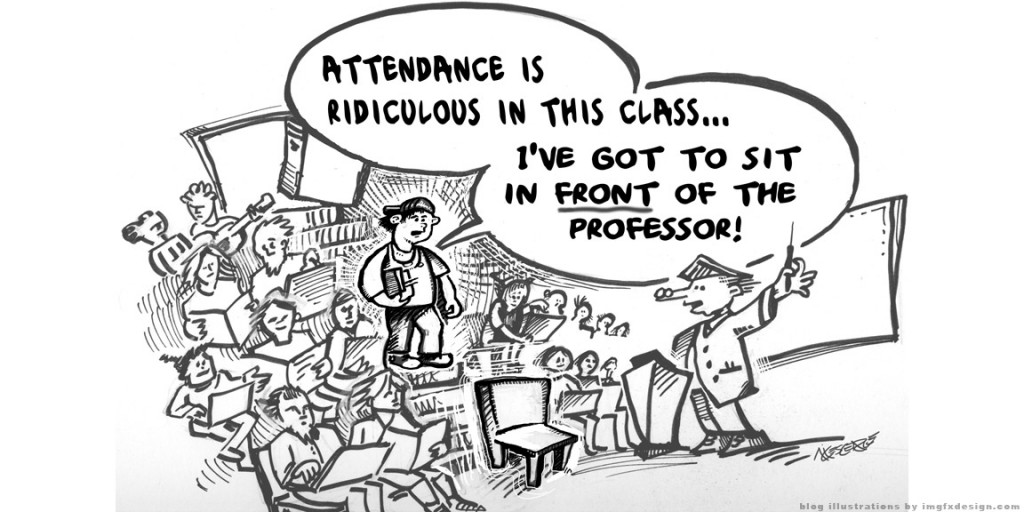
Motivating students to attend class involves a combination of techniques. Focusing class time on the application, versus content, of academic topics through real-world exercises engages committed, high-tier students and makes them eager to attend. Students should want to attend lectures to take advantage of the unique learning opportunity provided by their professors, but the reality is that many students are not mature and committed enough to realize what they are missing by not showing up for class.
Creating knowledge and problem-solving skills across all types of students is a challenge in teaching college. It is easy to get the high-tier, motivated students to attend class and learn, but professors can create incentives for less-motivated students to attend class and reap the benefits of attending class. It is extremely rewarding to motivate students coming into a course with low commitment levels and see them absorb the professor’s enthusiasm and passion for learning.
Achieving more than 90% attendance requires getting the lower- to middle-tier students to attend regularly, which involves a combination of techniques:
- Giving unannounced quizzes.
- Providing handouts in class, but not posting them on the university website.
- Grading on both attendance and class participation.
Unannounced Quizzes
Another effective technique to motivate attendance is giving unannounced quizzes—short (10-minute), surprise quizzes at the outset of class. The main objective of these quizzes is to force students to prepare for class so they have a basic understanding of terminology, concepts, and processes. Each time weekly readings are assigned, which is typically every other class, the students realize they might have a quiz. See post, “Application versus Content in Conjunction With Unannounced Quizzes” under Real-World Application Focus category.
The other great benefit of quizzes is that students realize that being absent means risking receiving a zero on a quiz. In a two-class-per-week format, usually about half the classes could have an unannounced quiz. If they are not sure when a quiz will be given, they will come to class rather than risk missing a quiz. That is a strong inducement to attend class.
Limiting Access to Class Handouts on University Website
You are a student debating whether or not to attend class and weighing the issues: “Hhhhhmmmm … I’d rather get a jump on Game Day coverage of tonight’s football game … I don’t need to attend class because I can get the class lecture slides and next week’s assignment on the university website.”
It has become commonplace for professors to post essentially everything covered during class on the university website platform that are designed to facilitate this practice. It doesn’t take a rocket scientist to realize that this approach makes it too easy for students to conclude that attending class is a lesser priority, optional or even totally unnecessary. Less-committed, immature students often do not realize that they are missing important learning opportunities when they miss class.
In my classes, I provide handouts that include detailed lecture slides, assignments, video segment training worksheets, and in-class exercises. At the beginning of every course, I let students know that my policy is that I do not post these to university websites, which is unique among my fellow professors. As expected, students do not like this, and I get a lot of complaints directly or through the administration. While working professionals have printers or copy machines at every turn, college students find printing out or copying class handouts an overwhelming undertaking. Students constantly come up after class to see if I have copies of handouts from classes they missed. Their expressions when I remind them of my policy tells it all … I have created a major inconvenience for them. However, I feel this so-called inconvenience is an important component in getting students to attend class. (For truly legitimate reasons for missing class, such as athletics, documented sickness, etc., I will e-mail or provide copies of handouts to students.)
Students see handouts as valuable and want to have them. If the only way to get their hands on the handouts and save themselves the inconvenience of having to get copies is to attend class, they will show up. They might complain, but they will show up—and they will become more engaged and involved in the class.
Grading on Attendance and Participation
In my classes, attendance and class participation each count three percent of the student’s grade. Documenting class attendance is a straightforward process of handing out an alphabetical roster, with each student signing their signature. Students have name tents displayed during class and I often spot-check the attendance logs while students are looking at video segments.
Making attendance and participation equally important means that students have to do more than show up and doze off in the last row; they have to speak up, express themselves, and respond to the professor and the course content. Even students with a low level of commitment will start to feel engaged if they are expected to be active participants. They start to feel that they, and their opinions, matter.
Gratifying Results
The techniques outlined in this article have resulted in attendance exceeding 90 percent, which is rather impressive, knowing that many undergraduates take a lackadaisical approach to attending class.
Be aware that a progressive approach that uses the techniques of not posting materials to the university website, unannounced quizzes, and grading class participation to ensure that students attend class and receive the benefits of an outstanding class environment will not be popular with many students—the support from faculty and administrative oversight is essential. On the positive side, though, many students who are initially resistant to this approach will realize its value, and will even express that realization.
One example of such a success is a student who, during the third week of the semester, complained in person to my department head about how rigorous my class was. As can be seen from his e-mail message, I turned around his entire viewpoint of his senior year of academics:
“After completing Professor Heller’s class I have taken on a completely different outlook, even though I’m in my senior year, on work ethics towards my college classes. I’m not going to lie, I took Professor Heller’s class thinking it was just an elective that I could blow off and easily get an A to boost my GPA. Well after the first few weeks of assignments I realized this class is no joke, and will require an honest effort with a lot of hard work. I’ve put more work into this class then all of my other classes combined. Although it was a lot of work, it wasn’t without reward ….”
When I was teaching three sections of a marketing management course, a student sent the dean an e-mail that included the following:
“Once I had a research study for another course that conflicted with my marketing class time on Tu/Th. I e-mailed Professor Heller to ask if I could attend his M/W 8 am class. I expected the class attendance to be sparse since Monday 8 am courses are notoriously under-attended. To my surprise, the classroom was filled to capacity. My experience in the 8 am class proved to me that students recognized that they could not make up for the knowledge they would acquire by attending Heller’s lecture.”
I encourage my teaching colleagues to consider these approaches to improving classroom attendance in their college classes. Both professors and students are bound to benefit.
Illustration by: Michael Scearce, IMGFX Design
